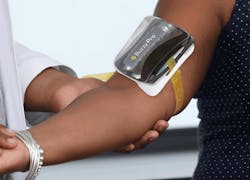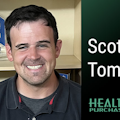Sharps safety in July of 2022 is just as important as ever.
The ways and means of ensuring it are continually enhancing, and the top healthcare companies are developing the best methods to keep moving forward.
However, in clinical settings, sharps injuries remain far too commonplace, especially in operating rooms (OR).
The backbone of sharps safety rests on the practice of logical methods that are still far too overlooked.
Yet, overlook them, and you could be looking at a wound on your own hands, or, by your own hands.
A brief history
In November of 2000, the Needlestick Safety and Prevention Act was signed into law, increasing the requirements for safer medical devices, with an emphasis on sharps and needlesticks. This was done in direct response to the occupational exposure present in the healthcare industry to bloodborne pathogens.
A sharp twist: COVID-19
The COVID-19 pandemic has not made it any easier.
The strains of COVID-19 have taken their toll across the healthcare environment, and have had a direct, negative impact on sharps safety. In effect, the pandemic has essentially stagnated the progression of sharps across the industry.
Moon observes that, “our frontline workers were dealing with an unprecedented infection, an influx of very sick patients, supply shortages necessary for effective protection and treatment, and a psychological strain. Because of this, proper sharps use and disposal, understandably, wasn’t everyone’s top priority at all times. The pandemic has highlighted the need for not only safe products, but for safe products that are available and intuitive for clinicians to use. If you can’t get the product or don’t know how to use it, it doesn’t matter how safe it is. This has shifted the conversation from not only product features, but also to product supply chain.”
Cincinnati Surgical has been specializing in surgical blade manufacturing for more than 80 years and has come to develop a keen understanding of sharps safety in developing their products.
“Our focus as a blade manufacturer is on sharps injuries from blades,” Kramer said. “There are two main causes of sharps injuries while using a blade: passing the scalpel, and removing the blade from the handle. We offer solutions for both. Training and adoption of these safety items are key to reducing sharps injuries. The easiest fix is to adopt the usage of blade removers and discontinue the practice of removing a blade from a scalpel handle with a hemostat.
“We offer retractable safety scalpels and a fully encapsulated blade management system that fits right on the handle a surgeon is used to using”, Kramer continued. “We know that the weight and feel of an instrument are important, which is why we worked with our partner, Swann Morton, to develop a safety blade called the KLEEN Blade Management System that maintains the weight and feel of a traditional blade and scalpel.”
The CDC estimates that annually there are 385,000 needlesticks and other sharps-related injuries to healthcare personnel.1 These injuries have been implicated in the transmission of more than 20 pathogens, including hepatitis B virus (HBV), hepatitis C virus (HCV), and human immunodeficiency virus (HIV).
Fear of Needles
There cannot be many people out there who actually like the idea of getting stuck with a needle. In fact, many fear it, despite the benefits of why we are being injected.
In response, companies such as Pain Care Labs have developed their products with a focus on lessening this stigma; relatedly, they have regularly run campaigns on site to highlight their focus on reduced pain.
Healthcare of Philadelphia brought us in to train staff on reducing anxiety of older children about vaccines, to reduce injury by addressing their unpredictability when frightened.
In regard to the direction the industry appears to be heading, Baxter states that, “IV access, and using techniques to reduce the need to re-stick will be helpful. For mass vaccination, needle-less injectors are certainly a huge direction in the field. In the past, the gas-propelled injectant hurt more, so the enthusiasm died down. Now pain is equivocal or better with some of the devices, and the convenience and safety of not having a needle to discard is moving groups to these interventions. Interestingly, since needle fear comes from the emotional recall of a previous injection experience, being approached with a device for a shot results in as much fear with or without a needle.”
Baxter describes how Pain Care Labs products specialize in reducing that all too common fear which is associated with sharps and needles.
“Our devices reduce fear and pain using a specific pain-cancelling vibration frequency and ice. The Buzzy and Buzzy Pro are the size of a computer mouse, and can be placed directly on a muscle, port site, or fistula to numb the area. Because our devices are a fraction of the cost of numbing creams and work on contact, they have been really adopted as emergency departments and labs have had to spend their budget on PPE during the pandemic. In one study, Buzzy saved $13 per point of pain reduction compared to EMLA.
For vaccines, the shape of Buzzy allows patients to hold and control the pain relief about 1-2 inches distant from the injection site. When you don’t feel a poke, you’re less likely to jerk away. Buzzy Pro and our HealthcareXL are attached proximal to the site of injection, so patients can be completely uninvolved while blood is collected or an injection is given. Giving the patients something to hold and a job to do can keep them from grabbing the nurse or the needle.”
Waste Management
Things that we are sure to notice all over hospitals and healthcare facilities alike are the brightly colored bins used to dispose of regulated medical waste.
Sterilis Solutions is regularly working to remediate regulated medical waste, increase sharps safety, and aid hospitals in gaining control over their on-site waste management.
The company has developed and manufactured a solution that takes waste management to the next level. Their proprietary technology, known as the Remediator, converts regulated RMW into harmless, confetti-like material.
Each year healthcare facilities in the U.S. produce millions of tons of biohazardous medical waste. This waste is predominantly related to red sharps containers and biohazard red bags.
“Here at Sterilis, we are ushering in a new way forward for RMW disposal.” said Andy Marshall, CEO of Sterilis Solutions. “The safety that it brings to healthcare workers is just one of the many ways the Remediator is changing the healthcare industry for the better.”
On top of the exorbitant amounts of waste produced by these sharps containers and biohazard bags, RMW traditionally demands extensive waste hauling services. Such services are regulatory and liabilities to countless medical facilites.
“We introduced the Remediator to not only help deal with the growing problem of RMW in our country, but also to further protect healthcare professionals,” said Marshall. “They are the backbone of the healthcare facilities and initiatives that are crucial to our livelihood.
The Remediator is a game-changer because it virtually eliminates the risk of accidental needle sticks. With our machine, you are able to insert the whole sharps container right in the product. From there, the Remediator does the rest.”
Keeping it neutral
The implementation of strict sharps saferty measures are vital to prevent injuries during perioperative care.
Practices such as double gloving, utilizing blunt suture needles, and establishing and using a safe or neutral zone will greatly aid in avoiding such injuries. Limiting hand-to-to hand passing of sharps will by itself eliminate one of the most common instances in which these injries occur.
The neutral zone is a designated area where sharps can be safely placed down and retrieved by another person, avoiding such potentially danger contact.
According to Nina Morales, Marketing Associate at Viscot Medical, “More and more we have noticed facilities seeking solutions to enforce the hands-free passing technique. One of the most common causes of sharps injuries within the operating room is improper passing of sharps; an NIH study has proven that the hands-free technique can reduce these by half.”2
AORN notes that a quarter of all suture needle injuries and over a half of scalpel injuries happen when a sharp instrument is being passed from one person to another; these staggering numbers are impossible to ignore.3
Morales continued, “sharps safety should be easy, intuitive, and- when possible- sustainable. We understand that adapting newer technologies and protocols can be challenging even if there is evidence that supports the change. The idea is to find devices that don’t drastically alter what’s already being done within the O.R. if possible. Reducing the amount of waste with a re-useable solution is a bonus.”
One of Viscot’s latest products is known as the Soffzone Neutral Zone, which is designed in a manner wherein it effectively serves as an invaluable ‘safe spot’ within an OR setting.
According to Morales, the Soffzone “solves many of the concerns around adapting a hands-free passing technique. The bright red color is something many clinicians already associate with sharps safety, as many needle counters and other sharps disposable items are already red, plus it is a highly visible color in the sea of blue and silver that is the O.R. The high visibility combined with the low profile makes passing sharps easy, and it enables an option for the clinicians to use their periphery vision, so they don’t need to take their eyes off the surgical site. We’ve also made our neutral zone autoclavable, so it’s re-useable and can be put right into every surgical kit.”
The size of the Soffzone Neutral Zone make it ideal for a Mayo stand, a portable tray where surgical equipment and supplies are kept close to the patient being operated on.
Morales added that “the Soffzone is sized for the Mayo stand, creating a clear and obvious spot for the designated passing of sharps; the instruments in use are typically already on the MAYO, making the Soffzone a minimally invasive change to the current O.R. layout.”
Holding things together
Air-Tite, a company with close to 100 years in developing syringes and needles, have developed a product that is built to enhance and ensure the safekeeping of needles.
Neil Garnache, President of Air-Tite, stated that, “the TSK Needle Holder helps prevent needle stick injuries by securing the hard-shell plastic capsules of cannulas and needles for safer loading and removal from the syringe. It also provides a tighter fit when fixing needles and cannula to the syringe. The weighted base and firm grip allows for a convenient, clean, and organized storage place for hypodermics during a treatment.”
Garnache commented on the recent surges in needle demand, with particular emphasis on the impact caused by the pandemic.
“In general, we are seeing that the manufacturers of safety needles and syringes experienced very high demand, particularly during the early stages of international vaccination efforts. Combined with recent international shipping/logistics challenges, this has led to inventory shortfalls and higher prices. In some cases, this has caused some practices to use conventional/non-safety devices when they would normally choose to use a safety device.
“It seems that the industry did not have sufficient stock or capacity of the appropriate safety devices (i.e. syringes with small volumes and low dead space features, safety needles with appropriate gauge and length and low dead space performance) to support a global immunization campaign. While some progress in product design and production capacity has taken place, additional gap assessment and correction may be needed.”
Advanced Medical Innovations specifically focuses in sharps safety products, such as MedMate, which continue to set standards for excellence in safe sharps management and injury prevention.
Mike Hoftman, President of Advanced Medical Innovation (AMI), commented that “due to the increase of very sick individuals with COVID over the last two years in hospitals, there was an increase of administering medication from vials into puncture ports for IV administration, which resulted in a high need for our newly patented product, MedMate.
“The MedMate provides a safe means to withdraw medication from a vial and inject it into a rubber port (IV line), without the need to use a standard hypodermic syringe and needle. In addition, it provides facilities with a cost saving opportunity, for, as opposed to using safety needles that need to be discarded after every injection, only one MedMate is required to complete a procedure.The MedMate is used for the complete procedure as many times as it is necessary.”
Hoftman continued, “this is the main issue: if a practitioner gets pricked with a sharps in healthcare facilities and the sharps is contaminated with the patient’s blood borne pathogen, there is a chance that the practitioner will get infected if the patient is infected. Therefore, it is critical for practitioners to use state of the art products and practice safety first.”
AMI sharps safety products also include the Sharps Safety Station and Ultimate sharps Safety Station series of Needle Counter boxes, which include many safety features such as: Scalpel Blade remover single handed, Hypo syringe recapper exchanger with one hand, and parking places for the scalpel and syringe safely inside the boxes.
Keeping our focus sharp
According to the CDC, 36% of blood and body fluid (BBF) exposures occur in Inpatient units, and 29% in the Operating room; the percentage of personnel exposed to BBFs are nurses (42%) and physicians (30%).
Furthermore, 30% of estimated needlesticks and other sharps related injuries occur in the OR.4
Those working in our hospitals and healthcare facilities can never be careful enough, especially when it comes to the safe and effective management of sharps and needle sticks.
Sharp objects should always be removed from use when deemed necessary, and perioperative personnel must use sharps with the required safety-engineered devices, in addition to utilizing safety scalpels, syringes, and needles.
Moreover, personnel must carefully abide by and execute work practice controls when using sharps, including neutral zones, no touch technology, and the safe containment and disposal of all items.
We must keep our focus sharp, for the best safety practices are always in our hands.
References:
1. Sharps Safety for Healthcare Settings. https://www.cdc.gov/sharpssafety/index.html Accessed on June 10, 2022.
2. Stringer, B., Haines, T., Goldsmith, C. H., Blythe, J., Berguer, R., Andersen, J., & De Gara, C. J. (2009). Hands-free technique in the operating room: reduction in body fluid exposure and the value of a training video. Public health reports (Washington, D.C. : 1974), 124 Suppl 1(Suppl 1), 169–179. https://doi.org/10.1177/00333549091244S119
3. Sharps Safety in the OR. https://www.aorn.org/-/media/aorn/guidelines/tool-kits/sharps-safety/sharps-safety-in-the-or-lets-walk-the-talk.pptx?la=en Accessed on June 10,2022.
4. The National Surveillance System for Healthcare Workers (NaSH). www.cdc.gov/nhsn/PDFs/NaSH/NaSH-Report-6-2011.pdf Accessed on June 10, 2022.
About the Author
Scott Tomko
Managing Editor
Scott Tomko was previously Managing Editor for Healthcare Purchasing News.






